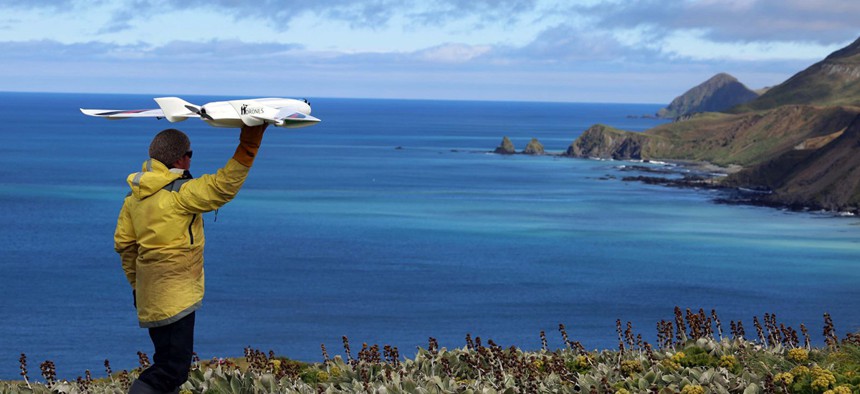Modified Drones Keep an Eye on the World’s Wildlife

Unmanned Research Aircraft Facility/uraf.org
The availability of reliable, off-the-shelf UAVs has made standard aerial surveillance far easier than it used to be, but drones don’t come out of the box ready for the kinds of projects conservationists throw at them.
For more than a year, Michael Moore has been trying to capture the breath of whales.
It’s an audacious idea, but Moore has help. A marine biologist at Woods Hole Oceanographic Institution in Massachusetts, he’s rigged a fleet of small unmanned aerial vehicles—UAVs, or drones—with samplers to catch whales’ exhalations from above. The aim is to get a good enough sample to analyze exhaled microbes and gain a better understanding of the cetaceans’ health.
Of course, stores don’t typically sell “whale breath-catching drones” off the shelf. Moore’s team has to make a number of adjustments to adapt his UAVs for the task at hand: setting them to calibrate on flat land so their gyros aren’t affected by the rocking boat, and moving the sample-catching petri dish from the bottom of the drone to the top.
“You’re using a down-drafting device to sample an updraft,” he explains. “Inherently, you’re asking it to do something it wasn’t designed to do.”
Moore, who hopes to get his first microbial analysis later this year, is one of many scientists now harnessing UAVs for wildlife conservation and research. Using drones, one team recently discovered there were twice as many orangutans in Sumatra as previously thought. UAVs have also been employed to map map Arctic shrubs, monitor wildlife in a Dubai national park, and even track down poachers in India. All it takes is a little engineering and ingenuity.
DIY droning
The availability of reliable, off-the-shelf UAVs has made standard aerial surveillance far easier than it used to be, but drones don’t come out of the box ready for the kinds of projects conservationists throw at them. That means researchers like Moore are increasingly using do-it-yourself modification techniques to prepare small drones for the unique aspects of tracking wildlife in sometimes harsh environments. Multispectral cameras, for example, allow drones see across a wider range of the electromagnetic spectrum, making it possible to analyze vegetation types in addition to animal life.
Serge Wich, a professor in the school of natural sciences and psychology at Liverpool John Moores University, and part of the Sumatran Orangutan Conservation Program, co-founded a group called Conservation Drones along with collaborator Lian Pin Koh at the University of Adelaide in Australia. The organization works exclusively on finding ingenious ways to modify UAVs for wildlife uses.
“We started off five years ago with a foam airplane, home-built on the kitchen table, with a camera that we sort of glued and taped together,” Wich says of the Sumatran orangutan survey. One of the project’s many adjustments addressed blurry images resulting from the vibration of the drones’ motors.
“We ended up with a very simple and cheap solution,” explains Koh, “which was just to have the camera sit on a piece of kitchen sponge. [That] reduced the vibration.”
There are other examples of scrappy drone customization. Jeff Kerby at Conservation Drones and Andy Cunliffe at the University of Edinburgh strapped point-and-shoot cameras to UAVs for sub-centimetre 3D mapping of Arctic shrubs—an indicator of how climate change is affecting the terrain. In August, state authorities in Uttarakhand in India announced a project to monitor wildlife and suspected poachers with as many as 12 UAVs.
Drones have also been launched to gather data from remote sensors. In 2013, after watching a TED talk by Koh, a team from New York University Abu Dhabi set up a drone that could wirelessly collect footage from camera traps in Dubai’s 31,000-acre Wadi Wurayah National Park. Historically, rangers had to fly to each of the traps—which stay in position for months and are activated by movement—in a Blackhawk helicopter to download images by hand. The “Wadi Drone” is able to do this from the air, digitally sucking up hundreds of photos on each trip.
Drone no harm
Benefits notwithstanding, sending noisy, heavy, fast-moving devices into the aerial habitats of endangered fauna has downsides—wildlife and drones don’t always mix. One project that attempted to survey an elephant herd with drones spooked its subjects so much that some of the pachyderms actually made a run for it.
We’re only beginning to understand the effect that drones can have on wild animals, says Jarrod Hodgson at the University of Adelaide. He cites a study from last year that found the heart rate of black bears in Minnesota rose significantly when a UAV flew overhead. The findings suggest that animals might be experiencing drone stress even when UAVs haven’t provoked an obvious behavioural response.
To address these concerns, Hodgson and Koh recently authored a draft “code of conduct” for drones used in conservation and research. “The key element in there is that we’re advising people to adopt a precautionary principle because we don’t fully understand the impact,” Hodgson says.
As personal drones become more common, national parks and conservation areas have also set rules around their use. Many, like Elk Island National Park in Canada—home to beavers, bison, pelicans and, of course, elk—are opting for outright bans.
But if conservationists can carry out their work responsibly, drones still have the capacity to revolutionize research in the wildest of areas. Imagine the potential of a system that could automatically identify things it takes hours for people to find in footage—not just an eye in the sky, but a brain too.
“It would be so exciting if we could automatically identify animals and humans in the data,” Wich remembers telling a colleague in the astrophysics department at his university. His colleague replied, “That’s something we might be able to help with.”





